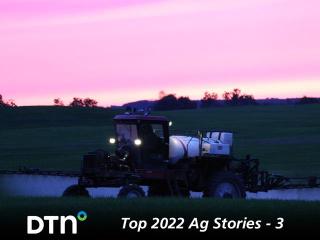OMAHA (DTN) -- Input prices for crop production, like the cost of many other items, saw large increases in 2022. Fertilizer, agricultural chemicals, and fuels all saw big jumps in price because of various supply issues and rising costs associated with manufacturing.
Unfortunately for crop producers, input prices do not appear to be dropping significantly as we move into 2023.
Fertilizer prices make up a large percentage of the total crop production costs. Prices rose in the first part of 2022 before leveling off in spring. Nutrients then saw a long, slow decline in prices in the second half of 2022.
Fertilizer prices were already higher because of various supply issues in recent years. The beginning of the Russia-Ukraine war in February 2022 was another factor that pushed prices higher. Russia and Belarus are large potash fertilizer producers -- the second and third largest potash producers in the world.
Supply from the Black Sea region stopped. Global prices spiked higher as there were major concerns supply from those countries was going to be hindered by the war. Major nutrient importing countries, such as Brazil, scrambled to find supplies to meet their fertilizer needs.
However, as it turns out, the war has had less of an impact on fertilizer supplies and prices than many feared.
Other fertilizer-producing regions of the world stepped up production levels after the war began. Canada, the world's largest producer of potash, increased production to offset the lost imports from Russia and Belarus.
By the end of 2022, while still fairly high historically, ample supplies of nutrients (especially in phosphorus and potash fertilizers) have some global fertilizer prices falling.
AG CHEMICALS COST MORE
Fertilizer wasn't the only input price costing more.
Shortages of agricultural chemicals due to the COVID-19 pandemic, labor shortages and increasing shipping costs all came together to cause prices to climb significantly higher in 2022.
DTN reported farmers saw large increases in the price for ag chemicals in 2022, in some cases twice as expensive as they were in 2021.
Glyphosate and glufosinate were the most affected active ingredients. Both were in high demand with glyphosate remaining the base of many weed control programs and glufosinate now a post-emergence spray option in soybean production.
Analysts hope increased production of these chemicals in 2023 will lead to lower ag chemical costs in the year ahead.
FUEL PRICES ROSE AND FELL
Fuel prices rose and then fell during the year. Much like fertilizer and ag chemicals, supply issues affected the flow of fuel; less supply pushed the fuel cost higher during mid-2022.
However, the year ended with lower fuel prices. Farmers will watch diesel prices closely, as well as propane, as the new year starts.
A colder-than-usual winter could cause propane prices to climb in early 2023. A cold front with extreme cold conditions, snow and high winds moved across the country just as winter started.







No comments:
Post a Comment